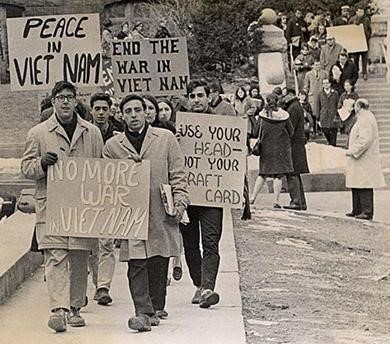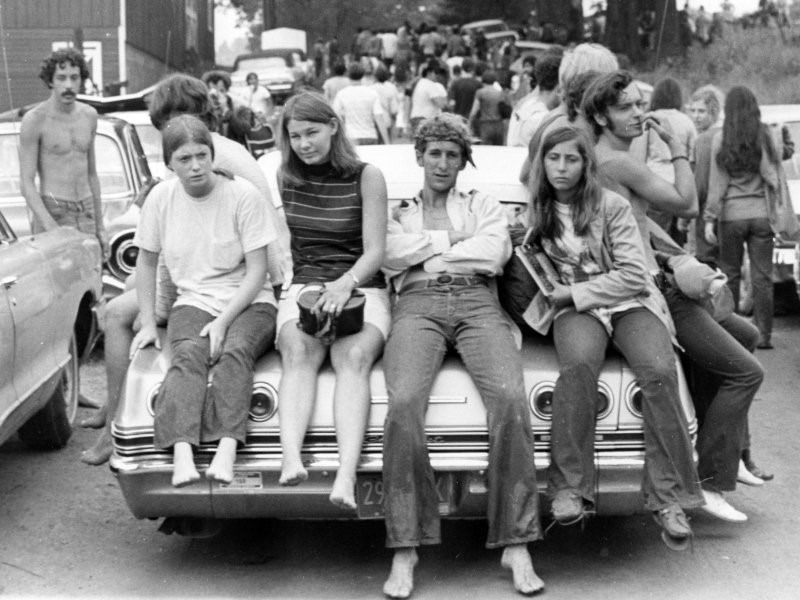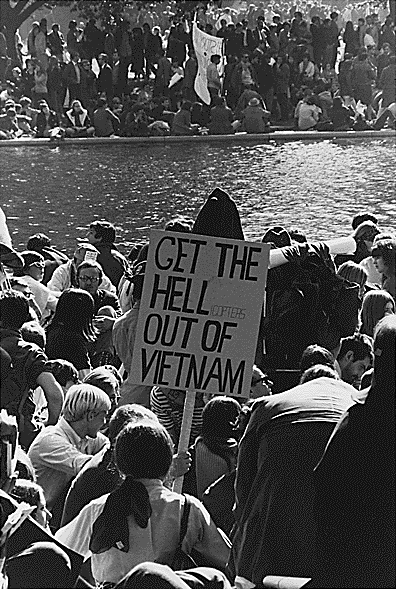Table of Contents |
By 1960, about one third of Americans lived in the suburbs. During the 1960s, the average U.S. family income rose 33%. A material culture blossomed during the decade; by 1969, approximately 80% of Americans owned at least one car. Consumers spent billions of dollars each year on entertainment; by 1969, almost 80% of them owned a black-and-white television.
Raised in this environment of affluence, millions of baby boomers streamed into the nation’s universities. Once there, they organized to support a variety of causes.
During the 1960s, many students (most of them White) arrived on campuses hoping to “find themselves.” Instead, they found traditional systems that confined them to rigid programs of study and rules that limited what they could do during their free time. Amid growing activism for civil rights and other social movements, many students found the control and conformity in effect at many colleges unacceptable and mobilized to change them. Students who held more radical views aligned themselves with the New Left.
One of the most prominent New Left groups was the Students for a Democratic Society (SDS). Organized in 1960 at the University of Michigan, the SDS expressed its philosophy in the “Port Huron Statement,” which was written by Tom Hayden and adopted by the SDS in 1962.
The opening paragraphs of the document identified concerns that many White, middle-class baby boomers shared in the early 1960s:
Port Huron Statement
“We are people of this generation, bred in at least modest comfort, housed now in universities, looking uncomfortably to the world we inherit.
When we were kids the United States was the wealthiest and strongest country in the world . . . .
As we grew, however, our comfort was penetrated by events too troubling to dismiss. First, the permeating and victimizing fact of human degradation, symbolized by the Southern struggle against racial bigotry, compelled most of us from silence to activism. Second, the enclosing fact of the Cold War, symbolized by the presence of the Bomb, brought awareness that we ourselves, and our friends, and millions of abstract ‘others’ we knew more directly because of our common peril, might die at any time. We might deliberately ignore, or avoid, or fail to feel all other human problems, but not these two, for these were too immediate and crushing in their impact, too challenging in the demand that we as individuals take the responsibility for encounter and resolution.”
To implement their vision of a more participatory democracy, the SDS and other New Left groups focused their activism on three areas:
The SDS and other student activists demanded that institutions of higher education allow more student participation in university governance. This became clear during the Free Speech Movement of 1964, which began at the University of California, Berkeley.
In 1964, the University of California, Berkeley—like many colleges and universities throughout the country—restricted students’ ability to advocate on behalf of political causes on campus. In October of that year, a student who was handing out literature for the Congress of Racial Equality (CORE) on the Berkeley campus refused to show university police officers his student ID card. The officers arrested him. The campus police car was immediately surrounded by angry students, who refused to let the vehicle move for 32 hours until the student was released. In December, Mario Savio and other activists organized a sit-in on the Berkeley campus.
In early 1965, university officials abandoned policies that restricted political speech. The success of the Free Speech Movement in Berkeley inspired student activism throughout the country during the 1960s and 1970s.
The New Left sought to mobilize poor people throughout the country, especially poor people of color, in an attempt to end poverty.
EXAMPLE
During the summer of 1964, a small group of White SDS members moved into a poor, predominantly Black neighborhood in Chicago and started the JOIN (Jobs or Income Now) program to combat racism and poverty. JOIN mobilized residents to resist urban renewal programs that threatened to displace them from their neighborhoods. It also called for the creation of police review boards to end police brutality against people of color and provided free breakfast and social and recreational activities to the neighborhood youth.Following the Gulf of Tonkin Resolution in 1964, the SDS and other New Left groups mobilized against the war in Vietnam.
Members of the New Left criticized Johnson’s decision to escalate the war because it was made without any public debate. In their view, a small political elite should not have the power to make foreign policy decisions that affected the majority of Americans. This was not the participatory democracy that the New Left had in mind. The New Left also rejected the U.S. containment policy and objected to violence committed against the Vietnamese people. For all of these reasons, an antiwar movement began during the spring of 1965, not long after the first American troops arrived in Vietnam.
In April 1965, the SDS organized an antiwar march and rally in Washington, DC. Approximately 20,000 people participated. In the same month, the faculty at the University of Michigan suspended classes for a day and conducted a 24-hour “teach-in” on the war. On May 15, 1965, the first national “teach-in” on the war took place on 122 campuses across the nation. Many of the teach-ins served as a setting for large antiwar rallies, like the one pictured below.

While the New Left challenged conventional liberalism by advocating for racial equality, economic security, and participatory democracy, the counterculture of the 1960s and 1970s rejected conventional middle-class life entirely through personal liberation and indulgence.
Young Americans associated with the counterculture, known as “hippies,” rejected the conventions of American society in a variety of ways.
EXAMPLE
Men sported beards and grew their hair long. Both men and women often wore clothing from non-Western cultures. The counterculture refused to observe traditional etiquette and behavioral norms.EXAMPLE
Casual sex between unmarried partners was another expression of the counterculture’s rejection of traditional norms. Drug use, especially of marijuana and psychedelic drugs like LSD and peyote, was common.
Some hippies dropped out of mainstream society altogether and joined communes. They shared a desire to live closer to nature, to respect the earth, and to reject modern life, including the pursuit of wealth and material goods.
Music, especially rock and folk music, occupied an important place in the counterculture.

Rock concerts provided young people with an opportunity to form impromptu communities that celebrated youth, rebellion, and individuality.
EXAMPLE
In mid-August of 1969, almost 400,000 people attended a music festival in rural Bethel, New York, that became known as Woodstock. A total of 32 acts were performed during the 3-day event. Many audience members consumed marijuana, LSD, and alcohol freely.
Another freelance reporter, Glenn Weiser, remembered Woodstock as follows:
Reporter Glenn Weiser on Woodstock
“Early on Friday afternoon [August 15, 1969], about a dozen of us got together and spread out some blankets on the grass at a spot about a third of the way up the hill on stage right and then dropped LSD. I took Orange Sunshine, a strong, clean dose in an orange tab that was perhaps the best street acid ever . . . . We smoked some tasty black hashish to amuse ourselves while waiting for the acid to hit and sat back to groove along with Richie Havens.
In two hours we were all soaring, and everything was just fine. In fact, it couldn’t have been better—there I was with my beautiful hometown friends, higher than a church steeple and listening to wonderful music in the cool summer weather of the Catskills. After all, the dirty little secret of the late ’60s was that psychedelic drugs taken in a pleasant setting could be completely exhilarating.”
One of the consequences of the social movements that emerged during the 1960s, including the New Left and the counterculture, was an increased questioning of the legitimacy of the Democratic Party and of the Great Society’s ability to solve the nation’s problems.
The unraveling of the liberal coalition that elected Lyndon B. Johnson as president in 1964 is ironic, because the Great Society achieved progress that previous reform movements, particularly Progressivism and the New Deal, were unable to accomplish.
EXAMPLE
By 1968, the percentage of Americans living below the poverty line had been cut nearly in half. Although more people of color continued to live in poverty compared to Whites, the percentage of poor African Americans had decreased dramatically.EXAMPLE
The creation of Medicare and the expansion of Social Security benefits improved the lives of many elderly Americans.EXAMPLE
Increased federal funding for higher education enabled more people to attend college than ever before.One of the reasons support for Johnson’s reform efforts lessened was his continued commitment to the Vietnam War. He was unwilling to withdraw forces from Vietnam, fearing that many Americans would then consider the effort a failure and that the U.S.S.R. and other communist nations would question America’s ability to enforce its containment policy.

By the late 1960s, as American casualties rose and more young men were drafted, people who had initially supported the Great Society and the liberal Democratic coalition began to question the president’s policies. Radical opposition to the war brought a number of other issues related to race, class, and gender to the forefront—issues that the Great Society had not resolved.
Instead of uniting Americans around a set of common, progressive goals, the Great Society and continued involvement in Vietnam divided the nation.
Source: This tutorial curated and/or authored by Matthew Pearce, Ph.D with content adapted from Openstax “U.S. History”. access for free at openstax.org/details/books/us-history LICENSE: CREATIVE COMMONS ATTRIBUTION 4.0 INTERNATIONAL
REFERENCES
Mario Savio quote, Free Speech Movement, 1964, CC: bit.ly/2oYmAcO